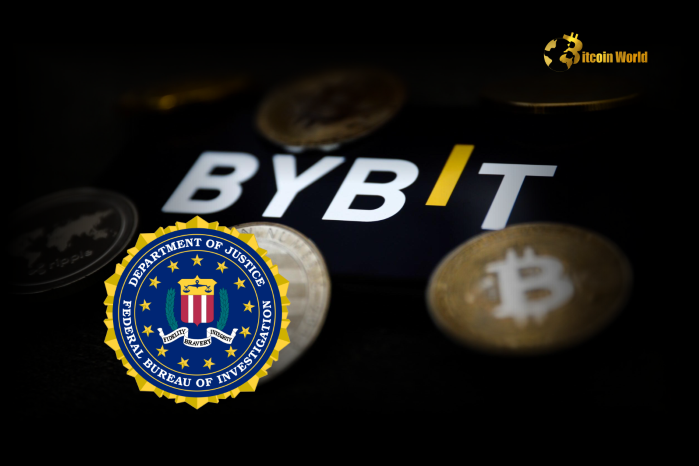
Get ready for a game-changer in the crypto world! Binance, a leading global cryptocurrency exchange, has just dropped some exciting news. They’ve officially enabled deposits and withdrawals for USD Coin (USDC) on the Sui network. This move marks a significant step forward for both Binance users and the burgeoning Sui ecosystem. If you’ve been waiting to seamlessly move your USDC between Binance and the Sui blockchain, your wait is finally over! Let’s dive into what this integration means for you and the broader crypto landscape. What Makes Binance Sui Support for USDC Significant? This isn’t just another routine update; the integration of USDC on the Sui network through Binance carries substantial weight. Here’s why it’s making waves: Enhanced Accessibility: Binance is a crypto giant, and by enabling Binance Sui support for USDC, they’re making this stablecoin far more accessible to their massive user base. This means millions of users can now directly interact with USDC on Sui without complex bridging procedures. Boosting Sui Network Adoption: For the Sui network, this integration is a major win. Having a widely recognized and trusted stablecoin like USDC readily available on their platform can attract more users, developers, and projects to the Sui ecosystem. It provides a crucial on-ramp for liquidity and expands the utility of the Sui blockchain. Streamlined User Experience: Say goodbye to complicated cross-chain swaps or intermediary steps. Sui USDC deposits withdrawals on Binance simplify the process of moving USDC to and from the Sui network. This ease of use is crucial for both experienced crypto users and newcomers alike. Lower Transaction Costs: The Sui network is known for its high throughput and low transaction fees. By utilizing Sui for USDC transactions, users can potentially benefit from significantly reduced costs compared to other networks. Expanding DeFi Opportunities on Sui: With USDC now readily available on Sui through Binance, it paves the way for a richer Decentralized Finance (DeFi) ecosystem on Sui. Expect to see more DeFi protocols, lending platforms, and trading opportunities emerge, leveraging the speed and efficiency of the Sui network. Navigating USDC Deposits and Withdrawals on Sui via Binance So, how do you actually use this new feature? The process is designed to be straightforward, reflecting Binance’s commitment to user-friendliness. Here’s a quick guide: Depositing USDC to Binance from Sui: Ensure you have USDC in your wallet on the Sui network. Log in to your Binance account and navigate to your wallet. Select “Deposit” and choose USDC as the cryptocurrency. From the network options, select “Sui”. Binance will provide you with a Sui deposit address. Copy this address and use it as the recipient address when sending USDC from your Sui wallet. Confirm the transaction and wait for it to be processed on the Sui network and Binance. Withdrawing USDC from Binance to Sui: Ensure you have a wallet address on the Sui network. Log in to your Binance account and navigate to your wallet. Select “Withdraw” and choose USDC as the cryptocurrency. Enter your Sui wallet address as the recipient address. From the network options, select “Sui”. Specify the amount of USDC you wish to withdraw. Review the transaction details and confirm the withdrawal. The USDC will be sent to your Sui wallet address. Important Note: Always double-check the network selection (Sui) when depositing or withdrawing USDC to ensure you are using the correct network. Sending funds to the wrong network can result in loss of funds. Boosting Crypto Stablecoin Adoption through Sui Integration The availability of crypto stablecoin adoption is crucial for the continued growth and maturation of the cryptocurrency space. Stablecoins like USDC play a vital role in: Providing Stability: In the volatile world of crypto, stablecoins offer a haven of stability, pegged to fiat currencies like the US dollar. This makes them ideal for hedging against market fluctuations and preserving value. Facilitating Transactions: Stablecoins are excellent for everyday transactions within the crypto ecosystem. Their price stability makes them predictable and reliable for payments, remittances, and trading. Enabling DeFi Growth: DeFi protocols heavily rely on stablecoins for lending, borrowing, yield farming, and providing liquidity. Increased stablecoin availability fuels the expansion of DeFi. Bridging Traditional Finance and Crypto: Stablecoins act as a bridge between traditional finance and the crypto world, making it easier for institutions and individuals to interact with digital assets. By integrating USDC on Sui, Binance is contributing to the broader adoption of stablecoins and fostering a more robust and versatile crypto ecosystem. This move empowers users with more options and reinforces the utility of both USDC and the Sui network. Potential Challenges and Considerations with Sui USDC Integration While the Binance Sui support for USDC is overwhelmingly positive, it’s important to acknowledge potential challenges and considerations: Network Congestion: Although Sui is designed for high throughput, increased activity due to USDC integration could potentially lead to temporary network congestion, especially during peak times. Users should be mindful of network conditions and potential delays. Security Risks: As with any crypto transaction, security remains paramount. Users must ensure they are using secure wallets, practicing good security hygiene (like strong passwords and avoiding phishing attempts), and being cautious when interacting with new platforms or DeFi protocols on Sui. User Education: While the process is simplified, some users, especially those new to crypto or the Sui network, might require education on how to properly deposit and withdraw USDC using the Sui network on Binance. Binance and the Sui community can play a role in providing clear and accessible educational resources. Regulatory Landscape: The regulatory landscape for stablecoins is constantly evolving. Both Binance and Circle (the issuer of USDC) must remain compliant with relevant regulations in different jurisdictions. Users should also stay informed about the regulatory environment in their region. Actionable Insights for Users and the Crypto Community What can you do with this exciting development? Here are some actionable insights: Explore Sui DeFi: If you’re interested in DeFi, now is a great time to explore the emerging DeFi ecosystem on Sui. With USDC readily available, you can participate in lending, borrowing, staking, and other DeFi activities on the Sui network. Take Advantage of Lower Fees: Consider using the Sui network for your USDC transactions to potentially benefit from lower transaction fees compared to networks like Ethereum. This can be particularly advantageous for frequent traders or users making smaller transactions. Stay Informed: Keep up-to-date with developments in the Sui ecosystem and the evolving features and functionalities of USDC Sui network integration . Follow Binance and Sui official channels for announcements and updates. Provide Feedback: If you use the new USDC on Sui feature on Binance, provide feedback to both Binance and the Sui community. Your input can help improve the user experience and shape future developments. Conclusion: A Powerful Leap for Sui and Binance Binance enabling deposits and withdrawals for USDC on the Sui network is more than just a simple listing. It’s a strategic move that unlocks exciting opportunities for users, strengthens the Sui ecosystem, and contributes to the broader adoption of stablecoins. This integration streamlines user experience, potentially lowers transaction costs, and opens doors to a vibrant DeFi future on Sui. As the crypto landscape continues to evolve, collaborations like this are essential for driving innovation and making crypto more accessible and user-friendly for everyone. Get ready to explore the possibilities that Binance USDC Sui integration brings – the future of decentralized finance is unfolding! To learn more about the latest crypto market trends, explore our article on key developments shaping Ethereum price action.
Bitcoin World
You can visit the page to read the article.
Source: Bitcoin World
Disclaimer: The opinion expressed here is not investment advice – it is provided for informational purposes only. It does not necessarily reflect the opinion of BitMaden. Every investment and all trading involves risk, so you should always perform your own research prior to making decisions. We do not recommend investing money you cannot afford to lose.
U.S. State Bitcoin Reserve Plans Hit Roadblock as Multiple Bills Rejected

Five states have so far blocked Bitcoin reserve bills, stalling efforts to integrate digital assets into public finance. Bitcoin World

Urgent FBI Warning: Crypto Platforms Must Block Transactions After Shocking Bybit Hack
Hold on to your digital wallets, crypto enthusiasts! The U.S. Federal Bureau of Investigation (FBI) has issued a stark warning that should send shivers down the spine of every crypto exchange and service provider. They’re urging everyone in the crypto space to take immediate action and block transactions tied to the staggering $1.4 billion Bybit hack . Yes, you read that right – billion with a ‘B’! This isn’t just another minor security breach; it’s a massive cyber heist, and the FBI is pointing fingers directly at a notorious culprit: North Korea’s Lazarus Group. Why is the FBI Issuing an Urgent Warning About the Bybit Hack? The FBI isn’t known for mincing words, especially when it comes to national security and financial crimes. Their public call to action regarding the Bybit hack underscores the severity of this situation. But why are they getting involved, and why is this so urgent? Here’s the breakdown: National Security Threat: The Lazarus Group, identified by the FBI as the perpetrators, isn’t just a random group of cybercriminals. They are a sophisticated, state-sponsored hacking organization linked to North Korea. Their activities are often aimed at generating revenue for the North Korean regime, which faces international sanctions. This makes the Bybit hack not just a financial crime, but a potential national security issue. Preventing Further Losses: The FBI’s warning is a proactive measure to prevent the stolen funds from being laundered and further disseminated throughout the crypto ecosystem. By urging crypto platforms to block associated transactions, they aim to cut off the flow of illicit funds and make it harder for the Lazarus Group to profit from their crime. Protecting the Integrity of Crypto: Incidents like the Bybit hack can erode trust in the cryptocurrency space. The FBI’s involvement signals a serious commitment to policing the digital asset world and protecting users and platforms from malicious actors. It’s about maintaining the integrity and long-term viability of the crypto market. Lazarus Group: Unmasking the Masterminds Behind the Crypto Heist So, who exactly is this Lazarus Group that the FBI is pointing to? They aren’t exactly newcomers to the world of cybercrime. Think of them as the James Bonds of the hacking world, but instead of saving the world, they’re emptying digital bank accounts. Here’s what you need to know about the Lazarus Group: North Korean Affiliation: The Lazarus Group is widely believed to be a state-sponsored hacking group operating under the Democratic People’s Republic of Korea (DPRK), commonly known as North Korea. Numerous cybersecurity firms and government agencies have linked them to the North Korean regime. History of High-Profile Attacks: They have been implicated in a string of audacious cyberattacks, not just in the crypto world but across various sectors. Their resume includes bank heists, ransomware attacks, and even the infamous Sony Pictures Entertainment hack in 2014. They are not shy about targeting big names and high-value targets. Sophisticated Tactics: The Lazarus Group is known for its advanced and evolving hacking techniques. They are adept at using malware, phishing scams, and social engineering to infiltrate systems and steal funds. They are constantly adapting their methods to stay ahead of cybersecurity defenses. Financial Motivation: A primary driver for the Lazarus Group’s cyber activities is believed to be generating revenue for the cash-strapped North Korean regime. Sanctions have severely limited North Korea’s access to traditional financial systems, making cybercrime a lucrative alternative source of income. The FBI’s confirmation of the Lazarus Group’s involvement in the Bybit hack is a significant development, adding another layer of seriousness to this already alarming situation. What Does This Mean for Crypto Platforms and Users? The FBI’s urgent appeal to crypto platforms has far-reaching implications for the entire cryptocurrency ecosystem. It’s a wake-up call, highlighting the ongoing risks and the need for robust security measures. But what does this really mean for platforms and individual users? For Crypto Platforms: Enhanced Security Protocols: This incident should serve as a catalyst for crypto platforms to re-evaluate and strengthen their security infrastructure. This includes investing in advanced threat detection systems, multi-factor authentication, and regular security audits. Transaction Monitoring: Platforms need to implement sophisticated transaction monitoring systems to identify and flag suspicious activities, especially those linked to known malicious actors like the Lazarus Group. This requires leveraging blockchain analytics and intelligence sharing. Collaboration and Information Sharing: The FBI’s call emphasizes the importance of collaboration and information sharing within the crypto industry and with law enforcement agencies. Platforms should actively participate in threat intelligence networks to stay ahead of emerging cyber threats. User Education: Platforms have a responsibility to educate their users about cybersecurity best practices, including how to protect their accounts and assets from phishing attacks and other scams. For Crypto Users: Vigilance and Awareness: Users need to be extra vigilant and aware of potential scams and phishing attempts. Be cautious about clicking on suspicious links or downloading attachments from unknown sources. Strong Security Practices: Employ strong, unique passwords and enable two-factor authentication (2FA) on all crypto accounts. Consider using hardware wallets for storing significant amounts of cryptocurrency offline. Stay Informed: Keep up-to-date with the latest cybersecurity threats and best practices in the crypto space. Follow reputable news sources and security experts for timely information. The $1.4 Billion Question: Can Stolen Crypto Be Recovered? The sheer scale of the $1.4 billion hack is mind-boggling. It raises a critical question: can such massive amounts of stolen cryptocurrency be recovered? The answer is complex and depends on several factors. Challenges in Crypto Recovery: Anonymity and Decentralization: Cryptocurrencies, by their nature, offer a degree of anonymity and operate on decentralized networks. This can make tracing and recovering stolen funds significantly more challenging compared to traditional financial systems. Mixers and Tumblers: Cybercriminals often use crypto mixers or tumblers to obfuscate the origin and destination of stolen funds, making it harder to track their movement on the blockchain. Jurisdictional Issues: Cybercrime often transcends international borders, creating jurisdictional challenges for law enforcement agencies trying to recover stolen assets. The Lazarus Group’s North Korean affiliation further complicates matters. Hope for Recovery: Blockchain Analysis: Despite the challenges, blockchain analysis tools are becoming increasingly sophisticated. Law enforcement agencies and specialized firms are using these tools to trace the flow of stolen funds on the blockchain, even through mixers. Collaboration and Information Sharing: International collaboration between law enforcement agencies and information sharing with crypto platforms and cybersecurity firms can enhance the chances of recovering stolen assets. Seizure and Asset Forfeiture: In some cases, law enforcement agencies have successfully seized and forfeited cryptocurrency assets linked to cybercrime. While full recovery may be difficult, partial recovery is sometimes possible. While the odds of recovering the entire $1.4 billion may be slim, the ongoing efforts by the FBI and other agencies, combined with advancements in blockchain analysis, offer a glimmer of hope for some level of asset recovery. Taking Action: Protecting the Future of Crypto The Bybit hack and the FBI’s urgent warning are a stark reminder that the cryptocurrency space is not immune to sophisticated cyber threats. It’s a call to action for crypto platforms , users, and the entire industry to prioritize security, vigilance, and collaboration. This isn’t just about preventing financial losses; it’s about safeguarding the future of crypto and maintaining trust in this innovative technology. By taking proactive steps to enhance security, share threat intelligence, and educate users, the crypto community can collectively strengthen its defenses against malicious actors like the Lazarus Group and build a more secure and resilient digital asset ecosystem. The time to act is now – the FBI has sounded the alarm, and it’s crucial to heed their urgent warning. To learn more about the latest crypto security trends, explore our article on key developments shaping crypto security and risk management. Bitcoin World











